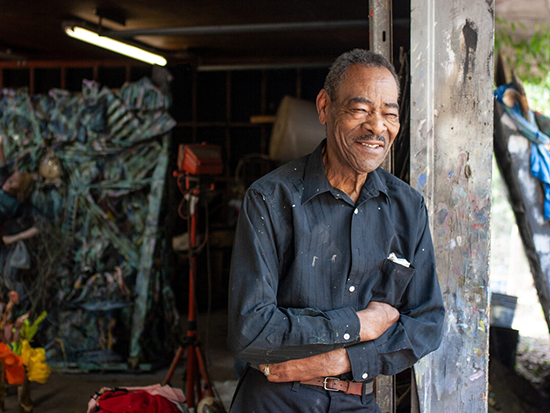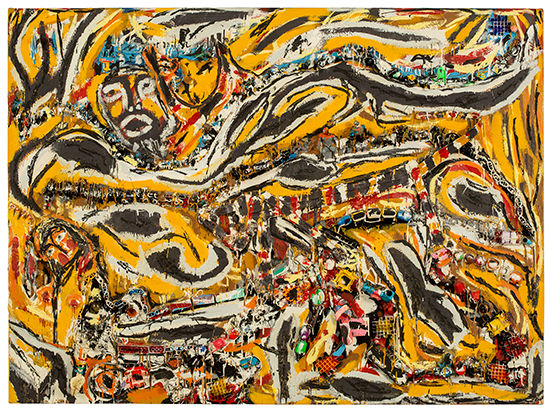 Thornton Dial Sr. in his McCalla, Alabama, studio. 1997. Photo by Jerry Siegel. ©️Jerry SiegelThe first comprehensive survey and largest exhibition in Alabama to-date of works by legendary artist Thornton Dial Sr. will be presented by the University of Alabama at Birmingham from Sept. 9-Dec. 10.
Thornton Dial Sr. in his McCalla, Alabama, studio. 1997. Photo by Jerry Siegel. ©️Jerry SiegelThe first comprehensive survey and largest exhibition in Alabama to-date of works by legendary artist Thornton Dial Sr. will be presented by the University of Alabama at Birmingham from Sept. 9-Dec. 10.
Dial, who was born in 1928 in Emelle, Alabama, and died in 2016, in McCalla, Alabama, was a pioneering vernacular artist known for using discarded materials and found objects to create sculptures and densely layered assemblages. His subjects range from his family and daily life to the Civil Rights Movement and other history. Although he received little formal education, Dial was a skilled machinist and metalworker.
The UAB exhibition “I, Too, Am Alabama,” presented by the Abroms-Engel Institute for the Visual Arts, is curated by Paul Barrett and organized by AEIVA’s Tina Ruggieri. The exhibition will open with a free panel discussion at 5:30 p.m. Friday, Sept. 9, followed by a reception. The exhibition will present many works by Dial that have never been exhibited or published before, as well as 360-degree video of his studio and documentary footage of the artist creating one of his signature drawings. The exhibition is timed to coincide with what would have been Dial’s 94th birthday, Sept. 10, 2022. This exhibition is supported in part by a grant from the National Endowment for the Arts and sponsors include Alabama Humanities Alliance.
The exhibition would not have been possible without the assistance of Dial’s family and features loans from the Estate of Thornton Dial, the Arnett Collection, the Birmingham Museum of Art, the Montgomery Museum of Fine Arts, and significant private collections both from the South and across the United States. AEIVA will publish a fully illustrated catalog featuring newly commissioned essays and contributions from scholars, artists, collectors, and Dial’s friends and family.
This exhibition was more than 10 years in the making, Barrett says.
“On November 12, 2010, a mutual acquaintance brought me to meet Thornton Dial in his studio in Bessemer, Alabama, for the first time,” Barrett said. “After nearly a decade of work, and two years of COVID delays, the first retrospective of Dial’s entire career will open very near to where Mr. Dial lived and worked for decades.”
 "How Things Work: The Parade of Life," 1992, Thornton Dial Sr. Enamel, plastic toys, wood, rope and industrial sealing compound on canvas on wood. 65 by 88.5 by 8 inches. Collection of Doug McCraw. Photo by Jerry Siegel. ©️2022 Estate of Thornton Dial / Artists Rights Society (ARS), New York.Along with the major exhibition at AEIVA, two companion exhibitions present the most comprehensive examination of Dial’s work ever presented in Alabama. “Anyone Can Move a Mountain” at Maus Contemporary will feature works by the artists commissioned to write for AEIVA’s catalog, and “I, Too, Am Thornton Dial” at the Samford University Gallery will focus on Dial’s extraordinary works on paper.
"How Things Work: The Parade of Life," 1992, Thornton Dial Sr. Enamel, plastic toys, wood, rope and industrial sealing compound on canvas on wood. 65 by 88.5 by 8 inches. Collection of Doug McCraw. Photo by Jerry Siegel. ©️2022 Estate of Thornton Dial / Artists Rights Society (ARS), New York.Along with the major exhibition at AEIVA, two companion exhibitions present the most comprehensive examination of Dial’s work ever presented in Alabama. “Anyone Can Move a Mountain” at Maus Contemporary will feature works by the artists commissioned to write for AEIVA’s catalog, and “I, Too, Am Thornton Dial” at the Samford University Gallery will focus on Dial’s extraordinary works on paper.
“I’m grateful for the opportunity to work with such enthusiastic partners to bring these shows to Mr. Dial’s hometown — and to share this work with his friends and family,” Barrett said.
John Fields, The Lydia Cheney and Jim Sokol Endowed Director of AEIVA, says the desire for a Thornton Dial exhibition has been in the back of his mind since the earliest days of AEIVA.
“Thornton Dial was one of the most significant artists Alabama has ever produced, but it is often too easy to take for granted the treasure in our own backyard,” Fields said. “We really wanted to emphasize Mr. Dial’s significance through the scope and ambition of this exhibit. Out of the 70-plus exhibitions AEIVA has generated since 2014, I can count on one hand the number of times we have dedicated the entirety of our exhibition spaces to a single artist.”
To present the first large-scale retrospective of Dial’s work in Alabama is a tremendous responsibility that AEIVA did not take lightly.
“First and foremost, it was important to me personally that the No. 1 priority for this exhibition was to serve as a proper homecoming for Mr. Dial,” Fields said. “We’ve worked very closely with Mr. Dial’s family every step of the way, and we are grateful for the level of trust they have extended to us.”
AEIVA, located at 1221 10th Ave. South, Birmingham, is open from noon-5 p.m. Tuesday-Saturday. Admission is free. Visit aeiva.uab.edu or call 205-975-6436 for information.
About the Artist
 "Man with His Bream," 1987, Thornton Dial Sr., Metal, vinyl, marbles, Splash Zone compound and paint. 44 by 27 by 12 inches. The Arnett Collection. Photo by Jerry Siegel. ©️2022 Estate of Thornton Dial / Artists Rights Society (ARS), New York.The art world knows him as Thornton Dial Sr.; but to people who knew him, he was “Mr. Dial” or “Buck.” Dial was born on Sept. 10, 1928, on a former cotton plantation where his teenage mother worked as a sharecropper. He grew up without a father and lived in poverty for much of his early life, raised by his great-grandmother and other women in his family, and eventually moved to Bessemer. He married his wife, Clara Mae, in 1951 and was father to five children: Thornton Jr., Patricia (who had cerebral palsy and died in 1987), Mattie, Richard and Dan.
"Man with His Bream," 1987, Thornton Dial Sr., Metal, vinyl, marbles, Splash Zone compound and paint. 44 by 27 by 12 inches. The Arnett Collection. Photo by Jerry Siegel. ©️2022 Estate of Thornton Dial / Artists Rights Society (ARS), New York.The art world knows him as Thornton Dial Sr.; but to people who knew him, he was “Mr. Dial” or “Buck.” Dial was born on Sept. 10, 1928, on a former cotton plantation where his teenage mother worked as a sharecropper. He grew up without a father and lived in poverty for much of his early life, raised by his great-grandmother and other women in his family, and eventually moved to Bessemer. He married his wife, Clara Mae, in 1951 and was father to five children: Thornton Jr., Patricia (who had cerebral palsy and died in 1987), Mattie, Richard and Dan.
Dial worked as a machinist, fabricating train boxcars at the Pullman Standard plant in Bessemer, Alabama, until it closed in 1981. To earn extra money to support his family, Dial cut hair in his living room. He loved to fish and created fishing lures from found materials for his own use and for sale. He also planted a community garden in the Pipe Shop neighborhood where he lived, renting additional land from the city of Bessemer and maintaining it with the help of his family. He worked for United States Pipe and Foundry Co., or U.S. Pipe, in Bessemer, and founded Dial Metal Patterns with his family, fabricating patio furniture and other metal objects, including benches for the VisionLand theme park.
After the death of his wife in 2005 and a stroke a few years later, Dial’s work took on a different perspective. The stroke caused some loss of fine motor function, and he stopped creating works on paper and began making works inspired by natural disasters he witnessed in Alabama or in the news that can be seen as allegorical references to his health problems and personal losses.
Dial remains one of Alabama’s most critically acclaimed artists. His first solo museum exhibition, “Image of the Tiger,” was jointly presented by the New Museum and the American Folk Art Museum in New York in 1993. His work was featured in the 2000 Whitney Biennial and has been the subject of major solo exhibitions in 2005 and 2011. Dial’s work can be found in the collections of the Metropolitan Museum of Art, Whitney Museum of American Art, Brooklyn Museum, Studio Museum in Harlem and Museum of Modern Art in New York; as well as the High Museum of Art; Indianapolis Museum of Art; Virginia Museum of Fine Arts; Museum of Fine Arts, Houston; de Young Museum in San Francisco; and many more. In his home state of Alabama, his work resides in the Birmingham Museum of Art, Jule Collins Smith Museum of Fine Arts, Montgomery Museum of Fine Arts, Paul R. Jones Museum of American Art and the Abroms-Engel Institute for the Visual Arts.
Events for “I, Too, Am Alabama”
AEIVA will present free programming around the exhibition “I, Too, Am Alabama,” featuring guest artists, community discussions and Dial family members. Visit uab.edu/aeiva for more information or for updates.
Friday, Sept 9
Opening night reception and panel, open to the public, with a discussion at 5:30 p.m. about vernacular art and Dial’s career, featuring esteemed scholars, artists and members of the Dial family. A free reception will follow.
 "Upsidedown Lady with the Longneck Tiger," 1991, Thornton Dial Sr. Watercolor and graphite on Lanaquaelle paper. 30 by 22 inches. Gift of Rebecca and Jack Drake. Collection of Abroms-Engel Institute for the Visual Arts, UAB. Photo by Jerry Siegel. ©️2022 Estate of Thornton Dial/ Artists Rights Society (ARS), New York. Saturday, Sept. 10
"Upsidedown Lady with the Longneck Tiger," 1991, Thornton Dial Sr. Watercolor and graphite on Lanaquaelle paper. 30 by 22 inches. Gift of Rebecca and Jack Drake. Collection of Abroms-Engel Institute for the Visual Arts, UAB. Photo by Jerry Siegel. ©️2022 Estate of Thornton Dial/ Artists Rights Society (ARS), New York. Saturday, Sept. 10
Dial Family Homecoming: A weekend celebration of Thornton Dial’s life at AEIVA, on what would have been his 94th birthday. For this event, AEIVA will focus on providing accessibility to the exhibition to Dial’s friends, family and neighbors. Shuttle service will be provided between Bessemer and AEIVA, and the event will be catered by Bob Sykes Bar-B-Q in Bessemer.
Thursday, Oct 6
Movie/Pizza/Tour Night, with a public screening and discussion premiering a special Thornton Dial episode of Alabama Public Television’s “Monograph” series.
Thursday, Oct 20
Chamber Music @ AEIVA, in partnership with the College of Arts and Sciences’ Department of Music. AEIVA will present a thoughtfully curated selection of classical music in response to the works and themes of “I, Too, Am Alabama.”
Wednesday, Nov. 2
Lunch and Learn: In partnership with UAB Arts in Medicine and ArtPlay Community Education, this discussion will focus on artists with disabilities and how those disabilities have affected their creative practice. Featuring guest artists Richard Dial and Jakob Dwight.
Thursday, Nov. 10
AEIVA Spoken Word: In partnership with the College of Arts and Sciences’ Department of English and its Creative Writing program, UAB graduate students will write and perform poetry in response to the works and themes of the AEIVA exhibition “I, Too, Am Alabama.”
Friday, Dec. 9
“I, Too, Am Alabama” closing reception, free and open to the public, in UAB’s AEIVA.